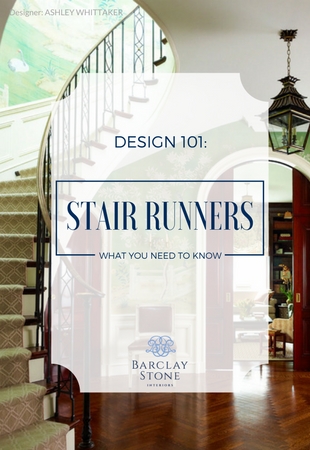
STAIR RUNNERS: 4 Reasons Why You Need a Stair Runner: A Helpful Guide. There are many folks out there (and, you may be one), who love the simplicity of a bare hardwood staircase. But, not me. I MUCH prefer a carpeted stair runner to a bare tread! And, let me tell you why (hint: reason #4 is my favorite!):
Let’s be honest; stairs take a beating. Think about it. If you have stairs in your house, how often are you traveling up and down those babies? LOTS. Do you have kids? Dogs? How often are they running up & down those stairs? Look at the treads – is the evidence of wear & tear showing?

If you don’t have a stair runner already, here are some reasons why you should think about installing one.
- SAFETY. Stair runners provide more traction and cushion to the steps – helping to prevent slippage. (ex: socks on hardwood)

Designer: Helen Green - NOISE REDUCTION. I make a lot of noise when I wear my heals! Stair runners mute those heavy footfalls!

Greige geometric stair runner. Waterfall application down stairs. Photo: The Carpet Workroom - PROTECTS HARDWOOD. It’s expensive to refinish hardwood floors and stairs! Maintain the beauty of them by covering up the most visibly used area with a stair runner.

Olive,black & eggplant wool plaid stair runner with decorative brass stair rods. Photo: Carpet Runners, UK - LOOKS FABULOUS! Okay, now that’s the designer in me. But, it’s true! Stair runners, visually, warm up your entryway. They help “invite” someone into your home. The carpet you select for your stair runner offers you an opportunity to add your personality to it: do you prefer a casual, welcoming striped runner or a sexy and flirty cheetah spot?

Wool cheetah print stair runner finished with a narrow cotton binding. Photo: The Carpet Workroom
Okay. Now that I’ve got you in my court, I want to forewarn you about a few decisions that you’ll have to make prior to installing your stair runner.
CARPET SELECTION. There are numerous options out there. However, I just want to caution you to a few facts. Not all rug weaves are suitable to be a stair runner. Since a stair runner gets the highest traffic in a house, an ideal carpet for this area would be a tightly woven wool or cotton.
- TIP#1: Select a tightly woven or dense pile wool with a low profile (low sheered cut piles or small loops). Carpets with a low profile are best (low sheered piles or small loops) because when the a tight or dense pile is bent over the tread, one is less likely to see the web backing of the carpet.
If you aren’t sure if the loop or pile is tightly woven or dense, try this test. Take the carpet sample and bend it over a tread. Do you see the back facing of the carpet? If you do, then it’s not going to be a great choice for the stairs.

- TIP#2: Some examples of rug weaves that might not be good options for stair runners are: Hand-knotted rugs, high cut pile carpets, rope weaves (too thick), jute rugs (too hard to clean), paper-fiber rugs (only suitable for low-traffic areas), cotton chenille rugs, polypropolene or outdoor rugs (too slippery), and some sisal rugs (again, might be too slippery).

Flat weave style stair runner with great edge detail woven in! Photo: via Merida Carpets
Once you’ve selected your stair runner carpet. You’ll need to make a couple more fundamental decisions. When your professional carpet installer comes to your house, he (she) will ask you these 2 questions. Your decision will affect how much carpet will need to be ordered.
Question #1: HOW WIDE DO YOU WANT THE STAIR RUNNER?

This is kind of a personal choice – as not all staircases are made equal. However, there is an industry standard for the width of a stair runner. In general, most runners are about 27″ to 30″ wide. Personally, if you have pretty hardwood underneath, I think it’s great to show it off a bit. I usually request a 2-3″ reveal on both sides. There is no right or wrong answer. However, the wider the stair – the more reveal you can have!

And, let me add that some stairs are treads are not stained or meant to be visible (maybe they’re made of plywood). In that case, a wall-to-wall installation is most appropriate (see photo above).
Question #2: INSTALLATION STYLE: Waterfall vs. Hollywood Wrap
I can hear you over there! You’re saying “WHA???” What the heck is Barclay talking about? Okay – the visuals will be best to describe the two applications of installation. But, here goes….
- WATERFALL INSTALLATION: This is the most common installation and it takes the least amount of carpet. Essentially, the carpet is attached at the base of each riser, allowing the carpet to cascade over the tread – hence, waterfall. This application is fantastic for patterned or striped carpets as the design runs fluidly down a straight staircase.

A waterfall installation of an Antelope style stair runner. Photo: Nicole Cohen 
A waterfall application of a woven cotton striped stair runner. Photo: The Carpet Workroom - HOLLYWOOD WRAP or UPHOLSTERED INSTALLATION: In this application, the carpet is completely hugging each step. The carpet is wrapped under the nose of each step and also attached at the base of each riser. This installation requires more carpet and more installation time, but it gives a more tailored and refined look to the stair runner.

A Hollywood wrap or upholstered style stair runner being installed.
So…that’s it for now. I hope that you’ve come away learning a bit more about stair runners. But, if you should have any questions or need my help with selecting a stair runner for your house – don’t hesitate to contact me!
Cheers! – Barclay



